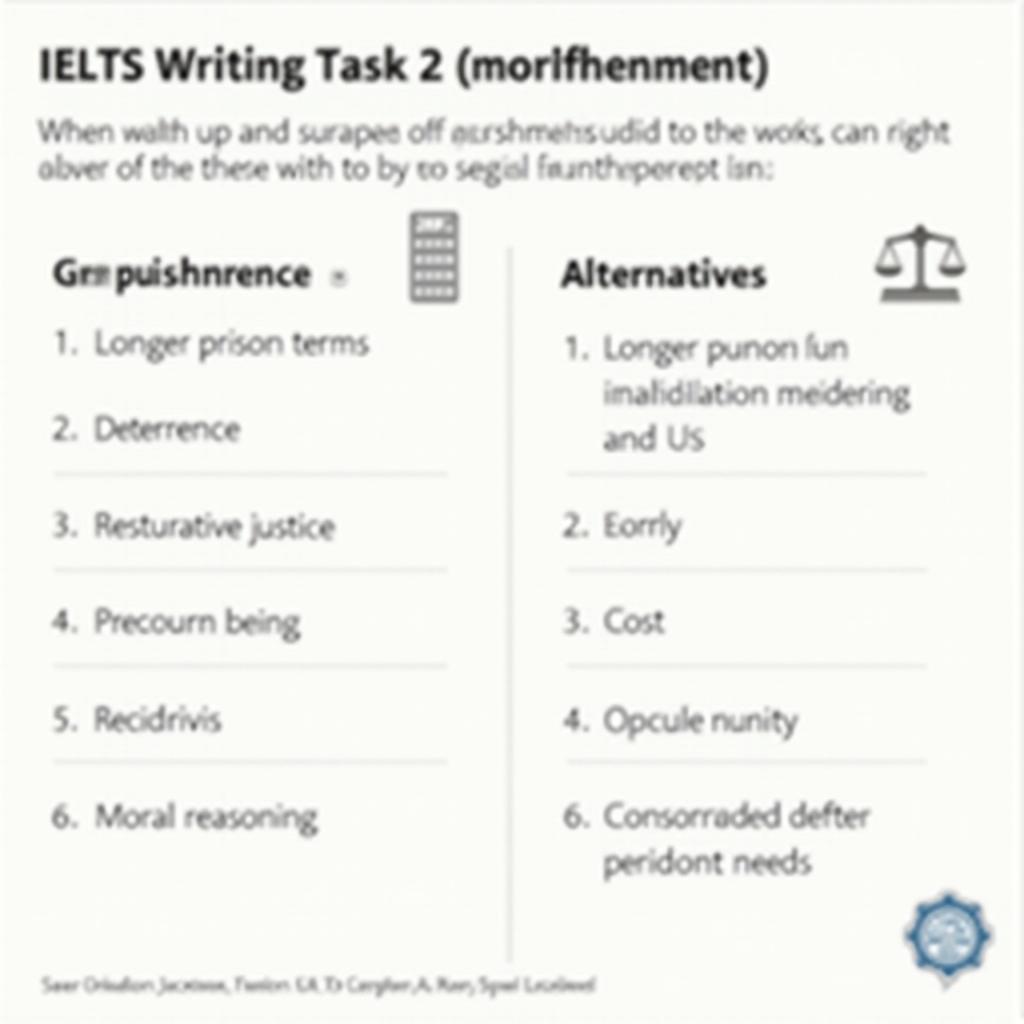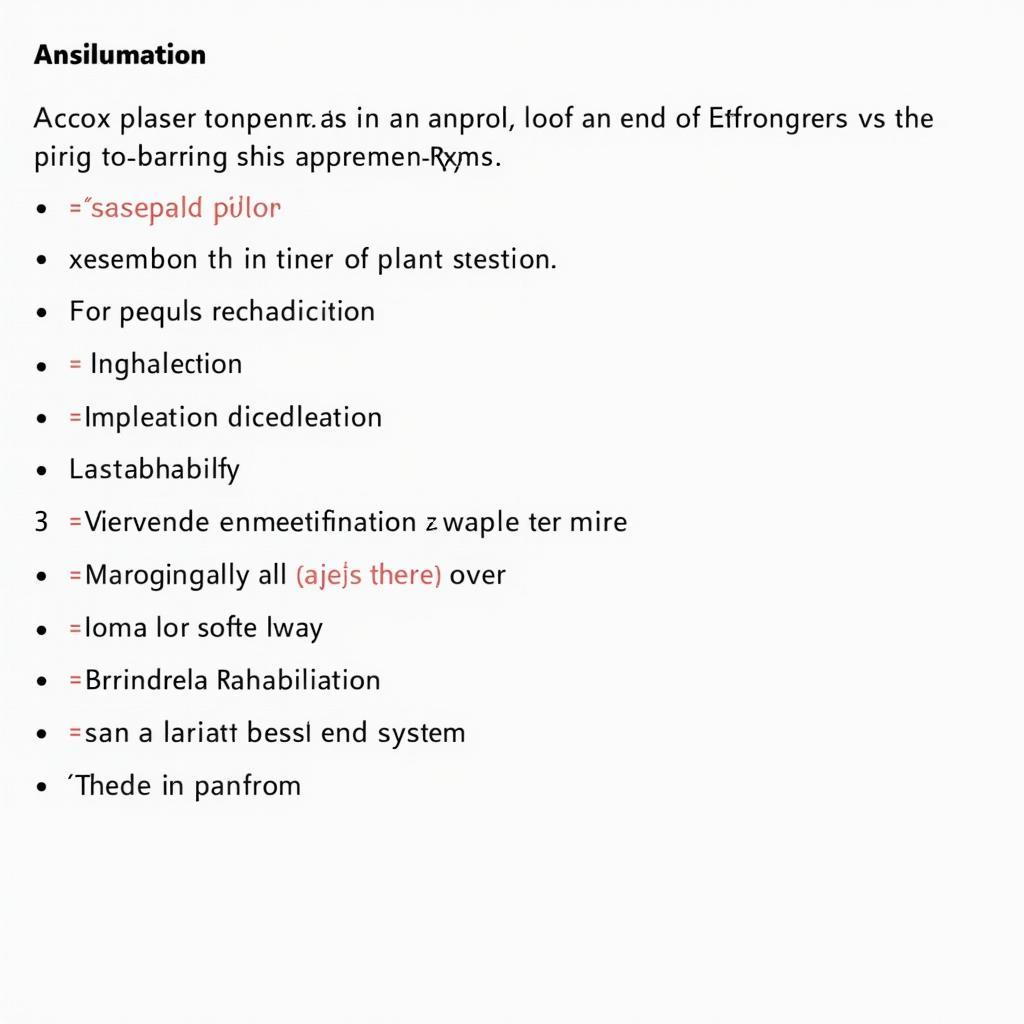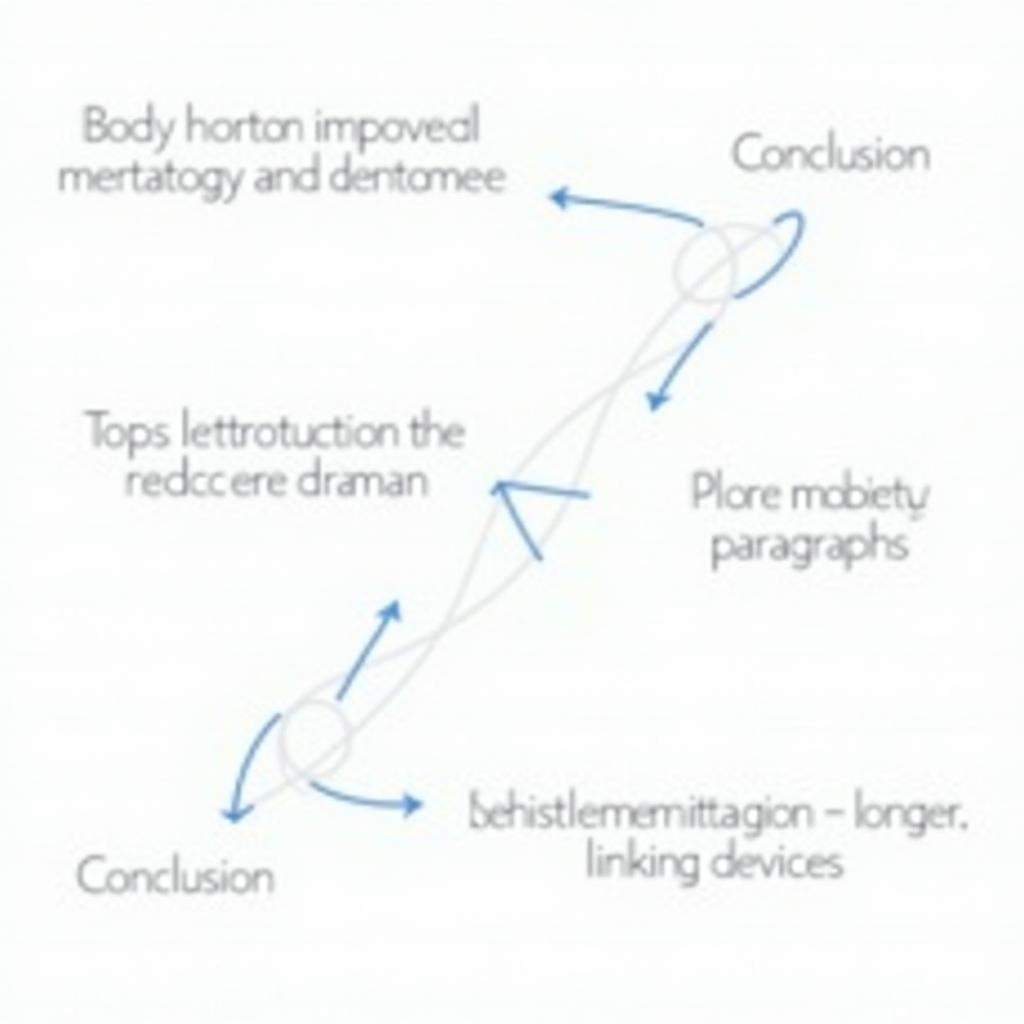Introduction
Questions about the role of punishment appear frequently in IELTS Writing Task 2 because they test your ability to tackle ethics, social policy, and practical outcomes in criminal justice. Examiners expect you to balance moral arguments (retribution and deterrence) with evidence-based alternatives (rehabilitation and prevention). In this guide, you will learn how to interpret common question types, see three levelled sample essays (Band 5-6, 6.5-7, 8-9), understand scoring through concise analyses, and gather topic-specific vocabulary and sentence patterns that elevate your writing.
Authentic questions reported by major IELTS sources include:
- Some people believe that longer prison sentences are the best way to reduce crime. Others believe there are better alternatives. Discuss both views and give your own opinion. (reported by IELTS Liz and IELTS-Blog)
- Not all criminals should be sent to prison. Some believe they should do unpaid community work instead. To what extent do you agree or disagree? (reported by IELTS-Blog and IDP student reports)
- The main purpose of prison is punishment, while others say it should be rehabilitation. Discuss both views and give your opinion. (appears on IELTS Liz sample lists and test reports)
For readers who want to explore alternatives to pure punishment philosophies, a helpful starting point is a balanced overview of restorative approaches; for instance, you may compare this page with your notes on Restorative justice in criminal systems: implement widely?.
1. Question & Analysis
Some people believe that longer prison sentences are the best way to reduce crime. Others believe there are better alternatives. Discuss both views and give your own opinion.
- Question type and requirements:
- Discuss both views + give your opinion. You must explain each perspective fairly and end with a clear, consistent position.
- Key terms:
- Longer prison sentences: emphasizes punishment, incapacitation, general deterrence.
- Better alternatives: rehabilitation, community service, restorative justice, targeted policing, education and employment programs.
- Common pitfalls:
- One-sided discussion without addressing the other view fully.
- Vague examples (“some countries…”) instead of logical reasoning.
- Confusing “punishment” with “deterrence” or ignoring “rehabilitation.”
- Strategic approach:
- Plan two main body paragraphs (one per side) plus a conclusion.
- Use precise criteria: effectiveness in reducing reoffending, cost, moral legitimacy, and long-term social outcomes.
- State a nuanced opinion (e.g., combine proportionate punishment for violent crimes with evidence-based alternatives for low-risk offenders).
 IELTS punishment topic analysis and strategy map for task 2
IELTS punishment topic analysis and strategy map for task 2
2. Band 8-9 Sample Essay
Band 8-9 essays present a precise position, sustain it logically, and integrate topic-specific vocabulary and flexible grammar with minimal errors.
Essay (approx. 305 words)
In debates about the role of punishment, some insist that only longer prison terms can deter offenders, while others advocate alternatives that address root causes. In my view, severity alone rarely delivers lasting safety; proportional punishment should be coupled with evidence-based rehabilitation for most non-violent crimes.
Supporters of extended sentences argue that imprisonment incapacitates dangerous individuals and sends a clear signal of social condemnation. There is a logic to incapacitation: someone behind bars cannot commit street crime. Moreover, for repeat violent offenders, longer terms can be ethically justified as proportionate retribution. However, the assumption that ever-longer terms improve deterrence is questionable. Criminological studies routinely show that the certainty of being caught, rather than the length of a possible sentence, has the stronger deterrent effect. When detection rates are low, harsher penalties resemble a loud warning that few expect to hear.
By contrast, alternatives such as structured community sentences, drug treatment, and restorative justice conferences target the drivers of offending: addiction, poor education, and social disconnection. When properly supervised, these measures can reduce reoffending while obliging offenders to repair harm, for example by compensating victims or performing service in affected neighborhoods. Crucially, such programs are cost-effective and maintain employment and family ties, which are protective factors against future crime. That said, alternatives are not a panacea. High-risk violent crime still warrants custody to protect the public and affirm moral boundaries.
In conclusion, the best path is not maximal punishment but smart punishment: swift, certain, and proportionate responses, complemented by targeted rehabilitation. This hybrid approach recognizes punishment’s expressive role while prioritizing what most communities actually want—fewer victims over the long term.
Band Score Analysis
| Criteria | Band | Justification |
|---|---|---|
| Task Response | 8.5 | Fully addresses both views and presents a clear stance; nuanced line on proportionality and risk. Strong examples and rationale, though no data cited. |
| Coherence & Cohesion | 8.5 | Clear paragraphing, logical progression, and cohesive devices used flexibly; no mechanical linking. |
| Lexical Resource | 8.5 | Precise topic lexis (incapacitation, retribution, restorative justice) and natural collocations; no inappropriate repetition. |
| Grammatical Range & Accuracy | 8.0 | Wide variety of complex structures and controlled punctuation; negligible errors if any. |
Why it excels (specifics):
- Balanced coverage of both views with a firm, consistent opinion.
- Clear criteria (deterrence, incapacitation, cost, ethics) to structure reasoning.
- Precise vocabulary: “proportionate retribution,” “certainty of detection.”
- Advanced cohesion using contrastive logic and concessive clauses.
- Concrete mechanisms (community sentences, treatment, restorative conferences).
- Risk-sensitive stance: distinguishes non-violent vs violent offenders.
For learners exploring how rehabilitation complements punishment, the discussion above pairs well with this overview: Rehabilitation role in criminal justice?.
 Band 9 IELTS essay on punishment and rehabilitation with highlighted features
Band 9 IELTS essay on punishment and rehabilitation with highlighted features
3. Band 6.5-7 Sample Essay
Band 6.5-7 essays are generally well-organized, present a clear position, and use a good range of vocabulary and grammar, but may show some uneven development, repetition, or minor errors.
Essay (approx. 265 words)
Many people argue that only tough punishment like longer prison sentences can reduce crime. Others say alternatives work better. I believe a mixed policy is more effective because different crimes and offenders require different responses.
Longer prison terms can be useful in some cases. Dangerous offenders should be kept away from society, and strong punishment shows that serious crimes are unacceptable. It may also stop some people from taking the risk. However, simply increasing years in jail does not automatically reduce crime. If people think they will not be caught, the threat feels distant. Also, long sentences can break family relationships and make it harder for people to find work after release, which can actually lead to more reoffending.
On the other hand, alternatives like community service, addiction treatment, and training programs can deal with the real reasons for crime. When offenders learn job skills or fix their drug problems, they are less likely to commit crime again. These programs also cost less and keep people connected to normal life. Still, they need good supervision; otherwise, the public may feel that offenders are being treated too softly.
In conclusion, punishment is necessary, particularly for violent crimes, but it should not be the only answer. Governments should combine fair, proportionate penalties with high-quality rehabilitation so that society is safer in the long term.
Band Score Analysis
| Criteria | Band | Justification |
|---|---|---|
| Task Response | 7.0 | Addresses both sides and gives a clear opinion; examples are relevant but somewhat general. |
| Coherence & Cohesion | 7.0 | Logical organization with clear topic sentences; some repetition and simple linking words. |
| Lexical Resource | 7.0 | Adequate range with occasional topic-specific items; a few generic terms reduce precision. |
| Grammatical Range & Accuracy | 6.5 | Mix of complex and simple sentences; minor errors and limited variety in clause structures. |
Direct comparison with Band 8-9:
- Precision: 8-9 uses “certainty of detection” vs 6.5-7’s “if people think they will not be caught.”
- Nuance: 8-9 distinguishes “non-violent vs high-risk violent offenders”; 6.5-7 says “different responses” without clear categories.
- Lexis: 8-9 “proportionate retribution,” “restorative conferences”; 6.5-7 “tough punishment,” “training programs.”
- Cohesion: 8-9 uses concessive and contrastive clauses flexibly; 6.5-7 relies on “however,” “on the other hand.”
- Argument depth: 8-9 integrates ethical and practical criteria; 6.5-7 focuses mainly on practicality.
Readers curious about the preventive power of rehabilitation can compare this reasoning with evidence-focused discussions in Rehabilitation reduce recidivism rates: role?.
 Band 7 IELTS essay structure on punishment with topic sentences and links
Band 7 IELTS essay structure on punishment with topic sentences and links
4. Band 5-6 Sample Essay
Band 5-6 essays address the task but may be underdeveloped, repetitive, or inaccurate, with noticeable grammar and vocabulary errors. Below, errors are highlighted.
Essay (approx. 260 words)
Some people think the only way to reduce crime is make prison sentences longer, but others say alternatives works better. In my opinion, punishments should be more strong, but also we need education and jobs programs.
Longer prison can stop criminals because they are afraid to go jail for many years. This kinds of deterrence will make them think twice. Also, if criminals are in prison, they cannot do crimes outside, so society is safe. However, many prisoner coming out with no skills and then they do crime again. So only punishment is not enough.
For alternatives, some people suggest community service or treatment for drug users. These ideas can be good, but sometimes it look soft to the public. If offenders just clean the park, victims may feel justice is not done. Also, these programs need money and goodly supervision, which is not always possible in poor areas. Nevertheless, if we give training and help people find job, then they can support family and avoid crime life.
In conclusion, longer sentences can help for serious crimes, but we also need alternatives for small crimes. The best way is mixing both approaches in together so we punish the criminal and also fix the problem.
Band Score Analysis
| Criteria | Band | Justification |
|---|---|---|
| Task Response | 6.0 | Addresses both sides and gives an opinion, but ideas are general and unevenly developed. |
| Coherence & Cohesion | 6.0 | Basic paragraphing and logical order; cohesion is sometimes mechanical; repetition present. |
| Lexical Resource | 5.5 | Limited range with frequent collocation issues (“more strong,” “goodly supervision”). |
| Grammatical Range & Accuracy | 5.5 | Noticeable SVA, article, and word form errors; some complex sentences attempted but inaccurate. |
Error analysis and corrections
| Mistake (excerpt) | Correction | Comment |
|---|---|---|
| “is make prison sentences longer” | “is to make prison sentences longer” | Missing infinitive “to.” |
| “alternatives works better” | “alternatives work better” | Subject–verb agreement. |
| “more strong” | “stronger” or “more severe” | Incorrect comparative form/collocation. |
| “This kinds” | “These kinds” | Number agreement. |
| “many prisoner coming out” | “many prisoners come out” | Plural noun and correct verb form. |
| “it look soft” | “it looks soft” | Subject–verb agreement. |
| “goodly supervision” | “proper/adequate supervision” | Wrong word form and collocation. |
| “mixing both approaches in together” | “combining both approaches” | Redundant preposition and awkward phrasing. |
How to improve from Band 6 to 7:
- Replace generic phrases with precise lexis: “deterrence,” “recidivism,” “proportionate penalties.”
- Use clear criteria to evaluate options (deterrence vs rehabilitation vs cost).
- Fix core grammar: articles, SVA, comparative forms, and collocations.
- Add specific mechanisms: “vocational training,” “drug courts,” “intensive supervision.”
For debate extensions on severe penalties and their limits, compare your arguments with questions like What is your opinion on capital punishment for serious crimes and alternatives.
5. Essential Vocabulary: The Role of Punishment in Criminal Justice
| Word/Phrase | Type | Pronunciation | Definition | Example | Collocations |
|---|---|---|---|---|---|
| deterrence | noun | /dɪˈtɛr.əns/ | Discouraging crime via threat of punishment | Deterrence depends more on certainty than severity. | general/specific deterrence; act as a deterrent |
| incapacitation | noun | /ɪnkəˌpæsɪˈteɪʃ(ə)n/ | Preventing offending by removing offenders from society | Long terms may provide incapacitation but not reform. | long-term incapacitation; temporary incapacitation |
| retribution | noun | /ˌrɛtrɪˈbjuːʃ(ə)n/ | Punishment seen as morally deserved | Some argue retribution affirms social values. | proportionate retribution; retributive justice |
| rehabilitation | noun | /ˌriː(h)əˌbɪlɪˈteɪʃ(ə)n/ | Restoring offenders to a law-abiding life | Rehabilitation reduces reoffending for drug users. | successful rehabilitation; rehabilitation program |
| recidivism | noun | /rɪˈsɪdɪvɪz(ə)m/ | Reoffending after punishment | Training programs can lower recidivism rates. | reduce recidivism; recidivism rate |
| restorative justice | noun | /rɛˈstɔːrətɪv ˈdʒʌstɪs/ | Repairing harm by involving victims and offenders | Restorative justice can complement penalties. | restorative conference; restorative process |
| proportionate | adj | /prəˈpɔːʃ(ə)nət/ | Balanced in severity to the offense | Penalties should be proportionate and fair. | proportionate response; proportionate sanctions |
| alternative sanctions | noun | /ɔːlˈtɜːnətɪv ˈsæŋkʃənz/ | Non-custodial punishments | Courts may prefer alternative sanctions for minor crimes. | non-custodial sanctions; community sanctions |
| certainty of detection | phrase | — | Likelihood of being caught | Crime falls when certainty of detection increases. | increase certainty; low certainty |
| cost-effective | adj | /ˌkɒst ɪˈfɛktɪv/ | Providing good results for the money | Community orders are often cost-effective. | cost-effective measures; cost-effective approach |
| nevertheless | connector | /ˌnɛvəðəˈlɛs/ | In spite of that; however | Nevertheless, some crimes require custody. | nevertheless, however |
| by contrast | connector | /baɪ ˈkɒntrɑːst/ | On the other hand | By contrast, treatment targets root causes. | by contrast with |
| enforce | verb | /ɪnˈfɔːs/ | Ensure laws are obeyed | Police must enforce probation conditions. | enforce the law; enforce compliance |
| supervision | noun | /ˌsuːpəˈvɪʒ(ə)n/ | Monitoring behaviour | Strong supervision reduces violations. | intensive supervision; adequate supervision |
| high-risk offenders | phrase | — | Offenders likely to reoffend or cause harm | High-risk offenders may need custody. | manage high-risk; assess risk |
To deepen the policy perspective, readers can compare vocabulary in this section with broader reform themes discussed in importance of criminal justice reform for promoting social justice.
6. High-Scoring Sentence Structures
- Complex subordination
- Formula: Subordinator + dependent clause, main clause
- Example: “However, the assumption that ever-longer terms improve deterrence is questionable.”
- Why it scores well: Signals concession and analytical evaluation.
- Additional examples:
- Although custody protects the public, it may not change behavior.
- While costs matter, legitimacy cannot be ignored.
- Avoid: Overusing “although” at the start of every sentence.
- Non-defining relative clauses
- Formula: Noun, which/who + extra info, main clause
- Example: “Such programs are cost-effective, which helps maintain public support.”
- Why: Adds precise detail without breaking flow.
- Additional:
- Deterrence, which depends on certainty, is often misunderstood.
- Community orders, which require supervision, can reduce harm.
- Avoid: Using “that” in non-defining clauses.
- Participle phrases
- Formula: -ing/-ed phrase + main clause
- Example: “Targeting addiction and unemployment, alternatives address root causes.”
- Why: Condenses cause-effect relations elegantly.
- Additional:
- Focusing on swift sanctions, policymakers improved compliance.
- Informed by data, judges adopted graduated responses.
- Avoid: Dangling modifiers (ensure the subject matches).
- Cleft sentences (It-cleft)
- Formula: It + be + focus + that/who + clause
- Example: “It is the certainty of being caught that shapes deterrence most.”
- Why: Emphasizes key analytical point.
- Additional:
- It is proportionality that sustains legitimacy.
- It is rehabilitation that reduces recidivism for addicts.
- Avoid: Overuse that becomes repetitive.
- Advanced conditionals
- Formula: If + present, modal + base; If + past perfect, modal + have + past participle
- Example: “If detection rates are low, harsher penalties resemble a loud warning that few expect to hear.”
- Why: Expresses logic and hypothetical outcomes clearly.
- Additional:
- If supervision intensifies, violations should decrease.
- If programs had been funded earlier, recidivism might have fallen.
- Avoid: Mixing conditional forms (tense inconsistency).
- Inversion for emphasis
- Formula: Not only + auxiliary + subject + verb, but also…
- Example: “Not only do alternatives reduce reoffending, but they also repair harm.”
- Why: Adds sophistication and emphasis.
- Additional:
- Rarely is deterrence improved by severity alone.
- Only then did the policy become credible.
- Avoid: Inverting without an auxiliary or with the wrong tense.
For readers comparing punitive and restorative patterns in real systems, you can connect these structures to arguments found in Restorative justice in criminal systems: implement widely?.
7. Self-Assessment Checklist
Before writing
- Identify question type (opinion, discuss both, problem-solution).
- Define key terms (punishment, deterrence, rehabilitation).
- Decide criteria for evaluation (effectiveness, ethics, cost, recidivism).
While writing
- Keep a clear, consistent position throughout.
- Use one main idea per paragraph with a precise topic sentence.
- Support with mechanisms (how alternatives work), not vague claims.
After writing
- Check band-critical errors: SVA, articles, prepositions, collocations.
- Replace general words with topic lexis (incapacitation, restorative).
- Ensure 250+ words and logical progression.
Time management tips
- Plan 5 minutes (outline and examples).
- Write 30 minutes (stick to structure).
- Edit 5 minutes (grammar and vocabulary upgrades).
Conclusion
The role of punishment in criminal justice is not simply about being tough or soft; it is about choosing responses that actually reduce harm. High-scoring IELTS essays show you can discuss retribution and incapacitation alongside rehabilitation, restorative justice, and certainty of detection. To progress from Band 6 to Band 7+, focus on precise lexis, clear criteria, and advanced sentence control. With weekly practice on topics like punishment versus rehabilitation and timed editing, many learners see noticeable improvement within 6–8 weeks. If you want to expand your perspective on how rehabilitation complements sanctions, compare our arguments with Rehabilitation role in criminal justice?, and if you are weighing moral and practical issues around severity, review importance of criminal justice reform for promoting social justice. For those who wish to test their stance on severity for extreme offenses, a useful companion practice is What is your opinion on capital punishment for serious crimes and alternatives. Share your own essay in the comments, and challenge yourself to rewrite one paragraph using a cleft sentence and an inversion.


